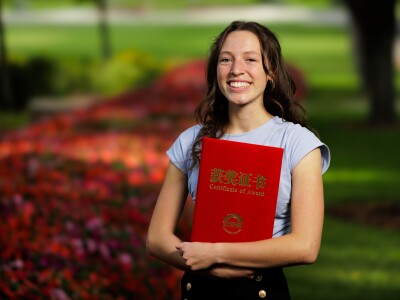New penstemon wildflower discovered high in Utah mountains

BYU professor Mikel Stevens is a plant hunter. When he’s hiking in remote parts of the country it’s because he’s trying to track down and document species of plants and flowers.
Most the time, his efforts pay off and he’s able to find what he’s looking for. And sometimes, something special happens.
“When I saw it, bells and whistles went off in my head; I sat there for two or three minutes quite stunned at its beauty,” said Stevens, a professor of plant and wildlife sciences. “It’s extremely rare. If I were to put numbers on this, I would put the chance of finding it as one in millions.”
What he chanced upon was a new and unique variant of one of our native wildflowers. Stevens was high on a dirt road just above Soldier Summit when he discovered a penstemon no one has ever documented — he knows because he is an expert in the genus of Penstemon. Roughly 18 inches tall with elongated bell shape blossoms in strong, “true pink” colors, including a bit of lighter pink striping, the flower is unlike anything he’s ever seen in his years of studying penstemons.
He believes there is a mutation somewhere in one or more of the genes responsible for blossoming — perhaps a jumping gene — that gives the flower its distinct multi-pink striping, where the colors seem to appear and disappear throughout each blossom. The coloring makes the flower quite a novelty and Stevens believes it could be an appealing cultivar for domestic flower beds if it can be reproduced successfully.
A trained plant breeder, Stevens has been working in his lab to reproduce the new wildflower ever since he discovered it — but it hasn’t been easy since the plant doesn’t produce seed. So far his team, which included undergraduate students Wesley Crump, Jed Grow and Sarah Harrison, have successfully propagated the penstemon only through asexual cuttings. They have also been able to get the wildflower growing through plant tissue cultures (in test tubes) in laboratory settings, but haven’t been able to get it to root in tissue culture yet.
“When I found it on the hillside, I went back to the remaining plant and wanted to collect seed and discovered it wasn’t producing seed,” Stevens said. “People ask how would it survive in nature with no seeds? The answer is it wouldn’t have survived in nature. I chanced on to it, but otherwise it was going to die out. Hopefully we can get it up and going for our gardens.”
Stevens would like to patent the new wildflower to make it commercially available, but to do that he needs to get it to reproduce with some slight genetic variations from its wild state. Plant patents are only granted in the U.S. to someone who has invented or developed and reproduced a distinct and new cultivar of plant — they can’t just pluck it from the mountainside and patent it. It requires “the hand of man” to be patentable. While he is hopeful that will ultimately happen, he believes that more than likely this particular flower will have a more limited sales opportunity as a novelty, not a “blockbuster” flower.
His interest, for what it’s worth, is not in making money, but in helping cultivate more drought-tolerant flowers for the future.
“We won’t get rich off of this, I just think it will be nice to get it into the public sector,” he said. “We here in the mountain west have very serious water problems coming down the road and we’re going to need to increase the number of drought-tolerant plants for our urban landscapes. We’re always going to want a BYU campus with lots of beautiful flowers, but the day will come when we will have to use less water.”
Hear more about the newly discovered penstemon in this interview between Dr. Stevens and BYU Radio’s Julie Rose.



